How to draw road cross section using Excel TO AutoCAD|volume|section are...
How to draw road cross section using Excel TO AutoCAD|volume|section are...
Cross section of Road
Featured snippet from the web
In the cross section of roads it is that portion of the roadway
between the outer edge of the outer traffic lane and the inside edge of
the ditch, gutter, curb or slope. Shoulders are provided for the safe
operation and to allow the development of full traffic capacity.
between the outer edge of the outer traffic lane and the inside edge of
the ditch, gutter, curb or slope. Shoulders are provided for the safe
operation and to allow the development of full traffic capacity.

Elements in Cross Section of Roads
Highway Cross Section Elements:
Road Cross-Section elements are those
features of a roadway which forms its effective width. There are two
types of road cross section elements:
features of a roadway which forms its effective width. There are two
types of road cross section elements:
Basic Elements of Cross Section of Roads
- Width of carriageway (including no. of lanes)
- …Central reservation (or median strip)
- …Shoulders
- Camber of the carriageway (cross slope)…
- Side-slopes of cuttings and embankments
Ancillary Elements
- Safety fences…
- Crash attenuation devices
- …Anti-dazzle screen…
- Noise barriers
1. Lane Width or Highway Travel Way:
The width of the surfaced road and the no of lanes should be adequate to accommodate the type and volume of traffic anticipated,
the assumed design speed of vehicles and in meeting oncoming vehicle or
passing slower ones. As traffic density, vehicle speed and truck widths
have increased, two lane highway have also increased in width from 16’
to the current recommended value of 24’ width.
the assumed design speed of vehicles and in meeting oncoming vehicle or
passing slower ones. As traffic density, vehicle speed and truck widths
have increased, two lane highway have also increased in width from 16’
to the current recommended value of 24’ width.
Urban Lane Width
Lane width is normally not less than 3.5m.
Narrower lanes are used for economic or environmental reasons. Two-way
local distributor route can be as narrow as 6.1m in carriageway width,
provided that kerb (curb) parking is is restricted. In urban areas width
of the near side lane is often increased, to:„
Narrower lanes are used for economic or environmental reasons. Two-way
local distributor route can be as narrow as 6.1m in carriageway width,
provided that kerb (curb) parking is is restricted. In urban areas width
of the near side lane is often increased, to:„
- Improve conditions for cyclists
- „Allow more space for commercial„
- Allow more space for commercial vehicles
Rural Lane Width
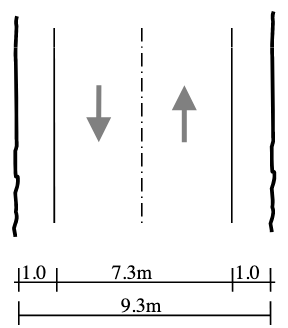
In
rural roads, recommended lane width is 3.65m to:reduce accidents and
increase capacity. Standard edge treatment on normal two-lane single
carriageways consists of a 1m strip of the same construction as the
carriageway on both sides with a solid white line so that total width
becomes 9.3m.
rural roads, recommended lane width is 3.65m to:reduce accidents and
increase capacity. Standard edge treatment on normal two-lane single
carriageways consists of a 1m strip of the same construction as the
carriageway on both sides with a solid white line so that total width
becomes 9.3m.
Standard for the interstate system set
lane width at 11’ for rural roads when traffic density is less than 200
vehicles per lane per hour. For other rural and all urban facilities
widths are set to be 22’. For primary highway carrying over 200
vehicles, lane widths are 11’ per 12’ depending on design speed and no
of commercial vehicles. For secondary roads desirable lane is 10’.
lane width at 11’ for rural roads when traffic density is less than 200
vehicles per lane per hour. For other rural and all urban facilities
widths are set to be 22’. For primary highway carrying over 200
vehicles, lane widths are 11’ per 12’ depending on design speed and no
of commercial vehicles. For secondary roads desirable lane is 10’.
Cross Sectional Elements of Road , Roadway Design
Cross Sectional Elements of Road
- Pavement surface characteristics
- Camber
- Kerbs
- Width of carriage way
- Road margins
- Width of formation
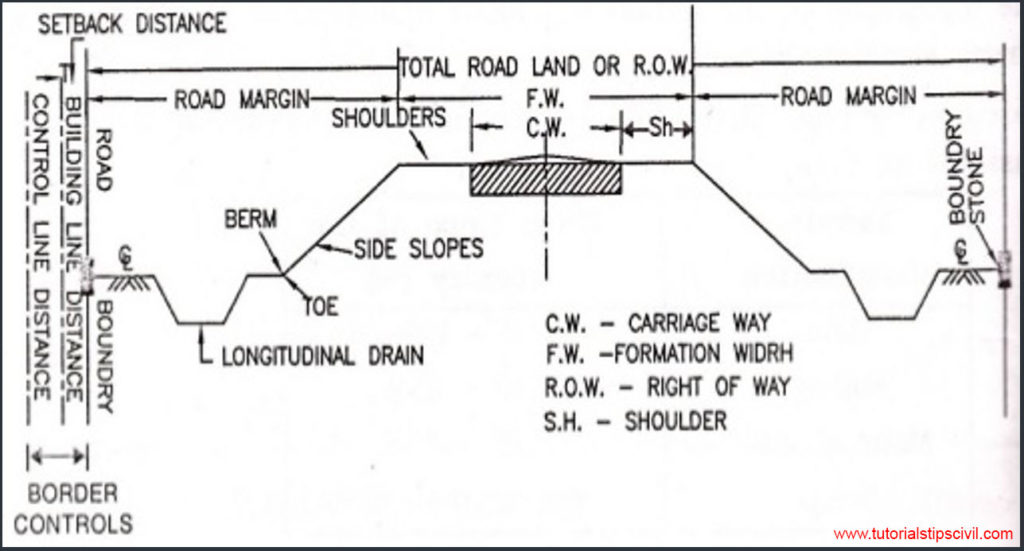
Pavement surface characteristics-
- FRICTION-
- Friction between the wheel and the pavement surface is a crucial
factor in the design of horizontal curves and thus the safe operating
speed.
- Friction between the wheel and the pavement surface is a crucial
- The frictional force that develops between the wheel and the
pavement is the load acting multiplied by a factor called the
coefficient of friction and denoted as f. - IRC suggests the coefficient of longitudinal friction as 0.35-0.4
depending on the speed and coefficient of lateral friction as 0.15
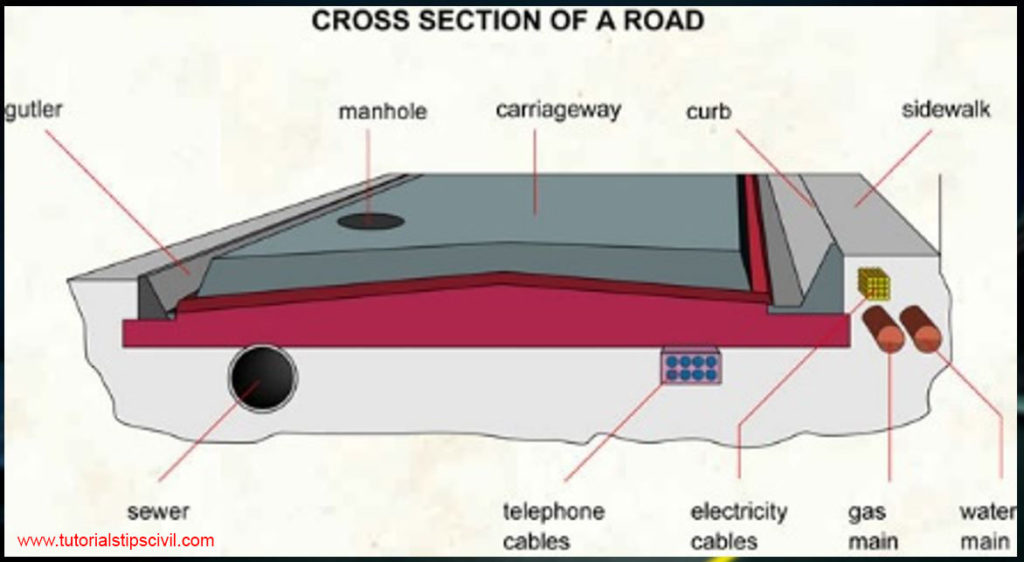
- UNEVENNESS
- Even if a road is constructed with high quality pavers, it is possible to develop unevenness due to pavement failures.
- Unevenness affect the vehicle operating cost, speed, riding comfort, safety, fuel consumption and wear and tear of tyres.
- Bump Integrator is device used to measure unevenness.
- LIGHT REFLECTION
- White roads have good visibility at night, but caused glare during day time.
- Black roads has no glare during day, but has poor visibility at night.
- Concrete roads has better visibility and less glare.
- DRAINAGE
- The pavement surface should be absolutely impermeable to prevent seepage of water into the pavement layers.
- Further, both the geometry and texture of pavement surface should help in draining out the water from the surface in less time.
CAMBER
- Camber or cant is the cross slope provided to raise middle of the
road surface in the transverse direction to drain of rain water from
road surface. - Camber is measured in 1 in n or n%
Kerbs
- Kerbs indicate the boundary between the carriage way and the shoulder or islands or footpaths.
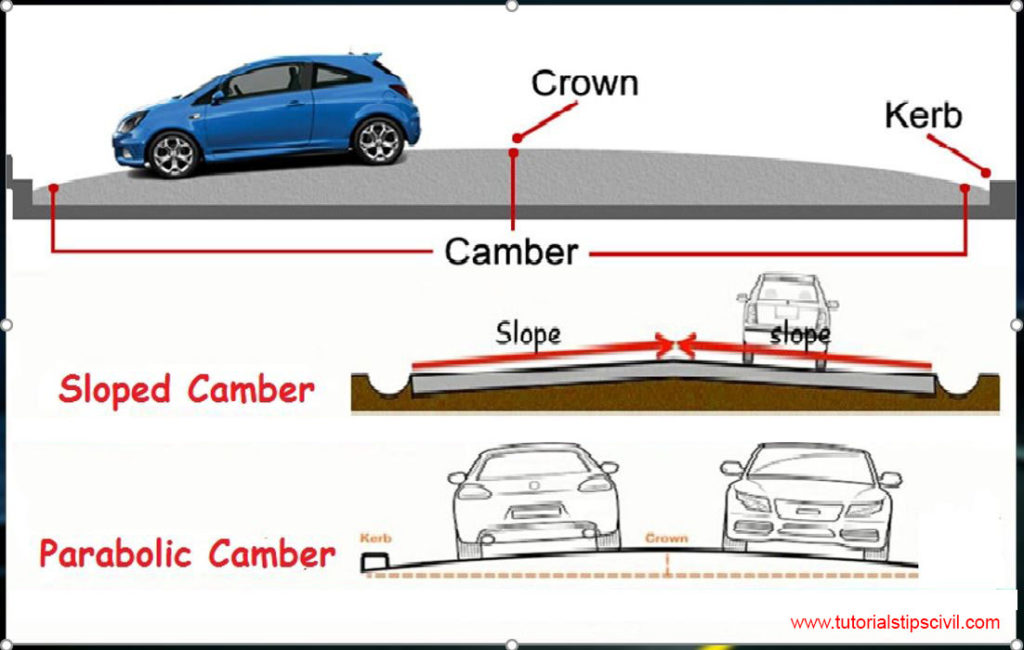
WIDTH OF CARRIAGE WAY
- Width of the carriage way or the width of the pavement depends on
the width of the traffic lane and number of lanes. Width of a traffic
lane depends on the width of the vehicle and the clearance. - Side clearance improves operating speed and safety. The maximum permissible width of a vehicle is 2.44.
Road margins
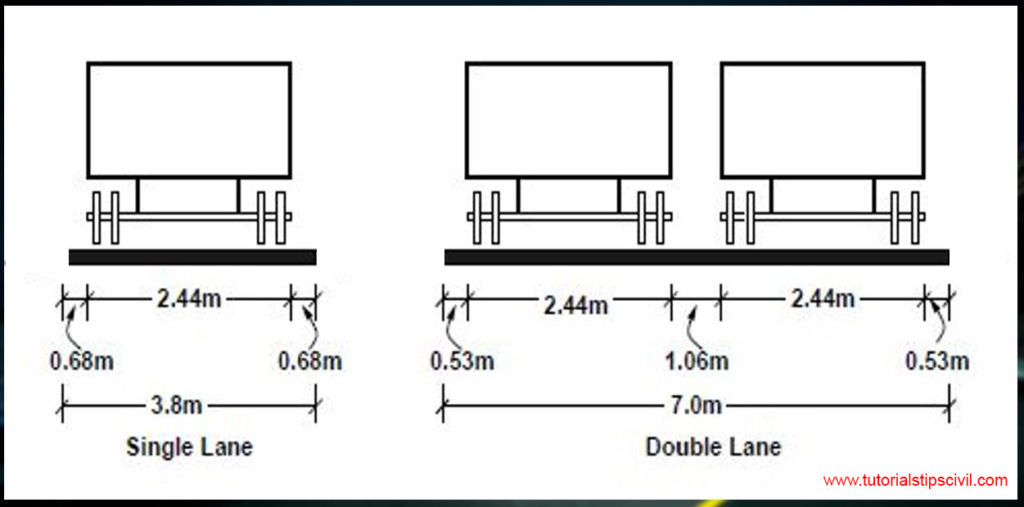
- Shoulders
- Shoulders are provided along the road edge and is intended for
accommodation of stopped vehicles, serve as an emergency lane for
vehicles and provide lateral support for base and surface courses.
- Shoulders are provided along the road edge and is intended for
- The shoulder should be strong enough to bear the weight of a fully
loaded truck even in wet conditions. It is desirable to have a width of
4.6 m for the shoulders.
- Parking lanes
- Parking lanes are provided in urban lanes for side parking. Parallel
parking is preferre because it is safe for the vehicles moving on the
road.
- Parking lanes are provided in urban lanes for side parking. Parallel
- The parking lane should have a minimum of 3.0 m width in the case of parallel parking.

- Bus-bays
- Bus bays are provided by recessing the kerbs for bus stops. They are
provided so that they do not obstruct the movement of vehicles in the
carriage way.
- Bus bays are provided by recessing the kerbs for bus stops. They are
- They should be at least 75 meters away from the intersection so that
the traffic near the intersections is not affected by the bus-bay.

- Service roads
- Service roads or frontage roads give access to access controlled
highways like freeways and expressways. They run parallel to the highway
and will be usually isolated by a separator and access to the highway
will be provided only at selected points.
- Service roads or frontage roads give access to access controlled
- These roads are provided to avoid congestion in the expressways and also the speed of the traffic in those lanes is not reduced.
- Cycle track
- Cycle tracks are provided in urban areas when the volume of cycle
traffic is high Minimum width of 2 meter is required, which may be
increased by 1 meter for every additional track.
- Cycle tracks are provided in urban areas when the volume of cycle

- Footpath
- Footpaths are exclusive right of way to pedestrians, especially in
urban areas. They are provided for the safety of the pedestrians when
both the pedestrian traffic and vehicular traffic is high.
- Footpaths are exclusive right of way to pedestrians, especially in
- Minimum width is 1.5 meter and may be increased based on the
traffic. The footpath should be either as smooth as the pavement or more
smoother than that to induce the pedestrian to use the footpath.

- Guard rails
- They are provided at the edge of the shoulder usually when the road
is on an embankment. They serve to prevent the vehicles from running off
the embankment, especially when the height of the fill exceeds 3 m.
- They are provided at the edge of the shoulder usually when the road
- Various designs of guard rails are there. Guard stones paint in
alternate black and white are usually use. They also give better
visibility of curves at night under headlights of vehicles

- Width of formation
- Width of formation or roadway width is the sum of the widths of pavements or carriage way including separators.
- and shoulders. This does not include the extra land in formation/cutting.
Right of way (ROW)
- Right of way (ROW) or land width is the width of land acquire for
the road, along its alignment. It should be adequate to accommodate all
the cross-sectional elements of the highway and may reasonably provide
for future development. - To prevent ribbon development along highways, control lines and building lines may be provided.
- Control line is a line which represents the nearest limits of future uncontrolled building activity in relation to a road.
- Building line represent a line on either side of the road, between which and the road no building activity is permitted at all.


sr acha kya app ny share kya ye software taky kise or ko be faida ho
ReplyDelete